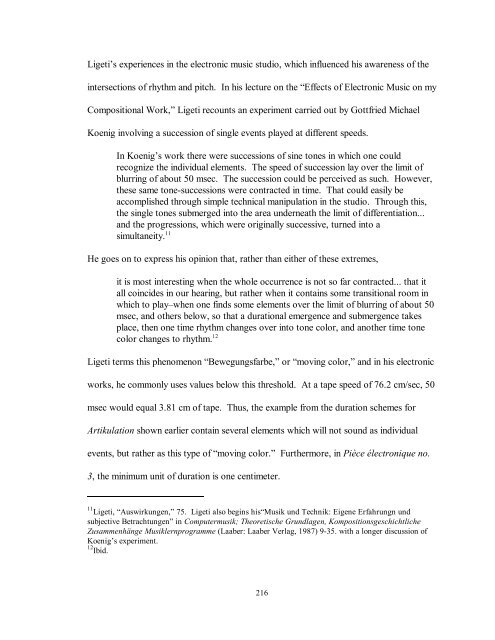THE ELECTRONIC WORKS OF GYÖRGY LIGETI AND THEIR ...
THE ELECTRONIC WORKS OF GYÖRGY LIGETI AND THEIR ...
THE ELECTRONIC WORKS OF GYÖRGY LIGETI AND THEIR ...
Create successful ePaper yourself
Turn your PDF publications into a flip-book with our unique Google optimized e-Paper software.
Ligeti’s experiences in the electronic music studio, which influenced his awareness of the<br />
intersections of rhythm and pitch. In his lecture on the “Effects of Electronic Music on my<br />
Compositional Work,” Ligeti recounts an experiment carried out by Gottfried Michael<br />
Koenig involving a succession of single events played at different speeds.<br />
In Koenig’s work there were successions of sine tones in which one could<br />
recognize the individual elements. The speed of succession lay over the limit of<br />
blurring of about 50 msec. The succession could be perceived as such. However,<br />
these same tone-successions were contracted in time. That could easily be<br />
accomplished through simple technical manipulation in the studio. Through this,<br />
the single tones submerged into the area underneath the limit of differentiation...<br />
and the progressions, which were originally successive, turned into a<br />
simultaneity. 11<br />
He goes on to express his opinion that, rather than either of these extremes,<br />
it is most interesting when the whole occurrence is not so far contracted... that it<br />
all coincides in our hearing, but rather when it contains some transitional room in<br />
which to play–when one finds some elements over the limit of blurring of about 50<br />
msec, and others below, so that a durational emergence and submergence takes<br />
place, then one time rhythm changes over into tone color, and another time tone<br />
color changes to rhythm. 12<br />
Ligeti terms this phenomenon “Bewegungsfarbe,” or “moving color,” and in his electronic<br />
works, he commonly uses values below this threshold. At a tape speed of 76.2 cm/sec, 50<br />
msec would equal 3.81 cm of tape. Thus, the example from the duration schemes for<br />
Artikulation shown earlier contain several elements which will not sound as individual<br />
events, but rather as this type of “moving color.” Furthermore, in Pièce électronique no.<br />
3, the minimum unit of duration is one centimeter.<br />
11<br />
Ligeti, “Auswirkungen,” 75. Ligeti also begins his“Musik und Technik: Eigene Erfahrungn und<br />
subjective Betrachtungen” in Computermusik; Theoretische Grundlagen, Kompositionsgeschichtliche<br />
Zusammenhänge Musiklernprogramme (Laaber: Laaber Verlag, 1987) 9-35. with a longer discussion of<br />
Koenig’s experiment.<br />
12<br />
Ibid.<br />
216

















